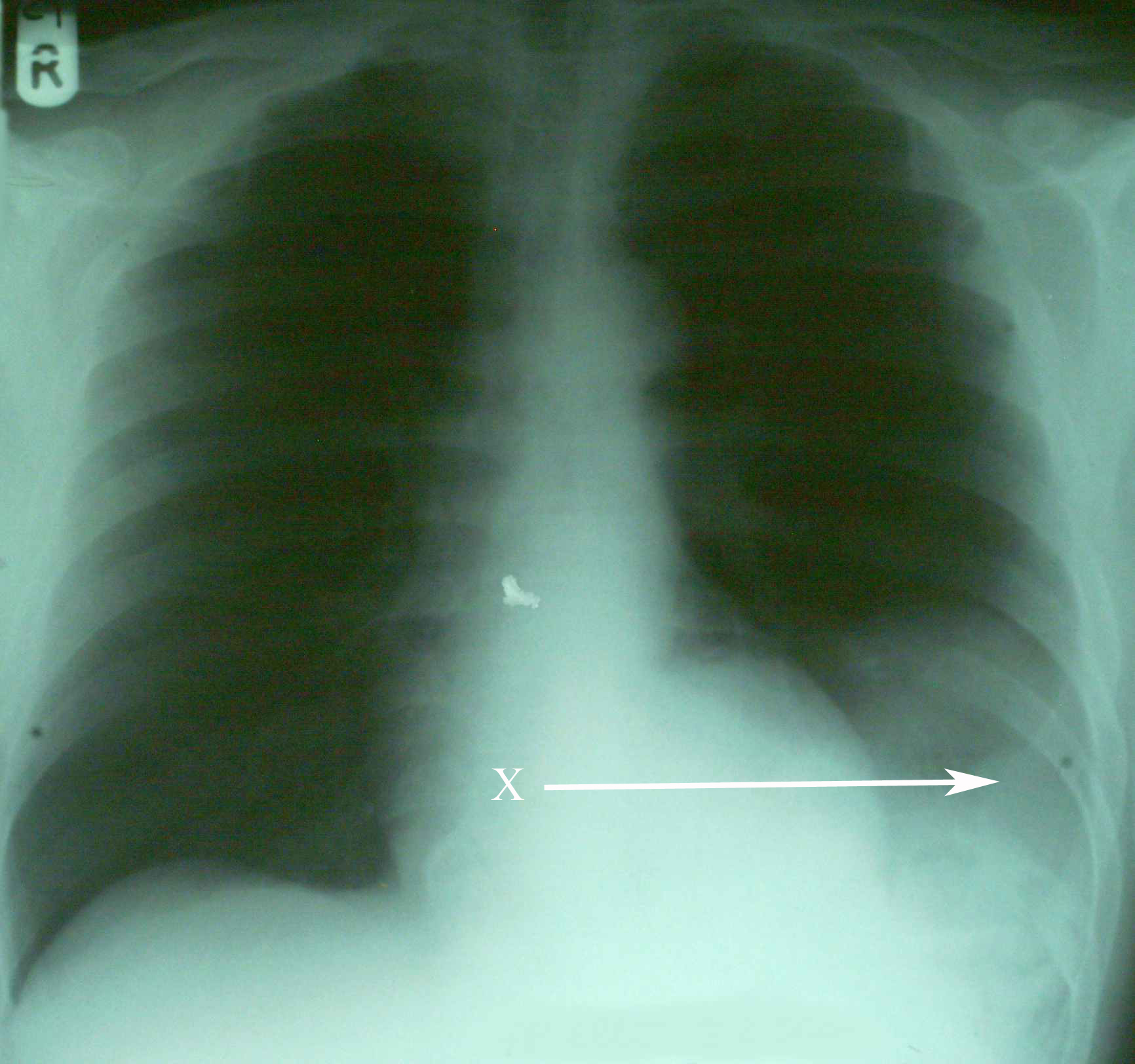Traumatic diaphragmatic hernia: Difference between revisions
AwniShahait (talk | contribs) No edit summary |
No edit summary |
||
| (6 intermediate revisions by 4 users not shown) | |||
| Line 1: | Line 1: | ||
__NOTOC__ | |||
{{Infobox_Disease | | {{Infobox_Disease | | ||
Name = Traumatic diaphragmatic hernia | | Name = Traumatic diaphragmatic hernia | | ||
Image = Diaphragmatic rupture spleen herniation.jpg | | Image = Diaphragmatic rupture spleen herniation.jpg | | ||
Caption = An [[X-ray]] showing the [[spleen]] in the left lower portion of the chest cavity (X and arrow) after a diaphragmatic tear | Caption = An [[X-ray]] showing the [[spleen]] in the left lower portion of the chest cavity (X and arrow) after a diaphragmatic tear| | ||
}} | }} | ||
{{ | {{Traumatic diaphragmatic hernia}} | ||
'''For patient information, click [[Traumatic diaphragmatic hernia (patient information)|here]]''' | |||
{{ | {{CMG}}; '''Associate Editor-in-Chief:''' [[User:AwniShahait|Awni D. Shahait, M.D.]][mailto:awnishahait@yahoo.com], The University of Jordan | ||
==[[Traumatic diaphragmatic hernia overview|Overview]]== | |||
==[[Traumatic diaphragmatic hernia historical perspective|Historical Perspective]]== | |||
== | ==[[Traumatic diaphragmatic hernia pathophysiology|Pathophysiology]]== | ||
Traumatic diaphragmatic hernia | |||
== | ==[[Traumatic diaphragmatic hernia causes|Causes]]== | ||
==[[Traumatic diaphragmatic hernia differential diagnosis|Differentiating Traumatic Diaphragmatic Hernia from other Diseases]]== | |||
==[[Traumatic diaphragmatic hernia epidemiology and demographics|Epidemiology and Demographics]]== | |||
== | ==[[Traumatic diaphragmatic hernia risk factors|Risk Factors]]== | ||
== | ==[[Traumatic diaphragmatic hernia natural history, complications and prognosis|Natural History, Complications and Prognosis]]== | ||
== | ==Diagnosis== | ||
[[Traumatic diaphragmatic hernia history and symptoms|History and Symptoms]] | [[Traumatic diaphragmatic hernia physical examination|Physical Examination]] | [[Traumatic diaphragmatic hernia laboratory findings|Laboratory Findings]] | [[Traumatic diaphragmatic hernia chest x ray|Chest X Ray]] | [[Traumatic diaphragmatic hernia CT|CT]] | [[Traumatic diaphragmatic hernia MRI|MRI]] | [[Traumatic diaphragmatic hernia ultrasound|Ultrasound]] | [[Traumatic diaphragmatic hernia other imaging findings|Other Imaging Findings]] | [[Traumatic diaphragmatic hernia other diagnostic studies|Other Diagnostic Studies]] | |||
==Treatment== | ==Treatment== | ||
[[Traumatic diaphragmatic hernia medical therapy|Medical Therapy]] | [[Traumatic diaphragmatic hernia surgery|Surgery]] | [[Traumatic diaphragmatic hernia primary prevention|Primary Prevention]] | [[Traumatic diaphragmatic hernia secondary prevention|Secondary Prevention]] | [[Traumatic diaphragmatic hernia cost-effectiveness of therapy|Cost-Effectiveness of Therapy]] | [[Traumatic diaphragmatic hernia future or investigational therapies|Future or Investigational Therapies]] | |||
== | == Case Studies == | ||
[[Traumatic diaphragmatic hernia case study one|Case #1]] | |||
== | ==Related Chapters== | ||
*[[Diaphragmatic rupture]] | *[[Diaphragmatic rupture]] | ||
[[Category:Emergency medicine]] | [[Category:Emergency medicine]] | ||
[[Category:Pulmonology]] | [[Category:Pulmonology]] | ||
[[Category:Disease]] | |||
{{WH}} | {{WH}} | ||
{{WikiDoc Sources}} | {{WikiDoc Sources}} | ||
Latest revision as of 21:36, 11 February 2013
| Traumatic diaphragmatic hernia | |
 | |
|---|---|
| An X-ray showing the spleen in the left lower portion of the chest cavity (X and arrow) after a diaphragmatic tear |
|
Traumatic diaphragmatic hernia Microchapters |
|
Differentiating Traumatic Diaphragmatic Hernia from other Diseases |
|---|
|
Diagnosis |
|
Treatment |
|
Case Studies |
|
Traumatic diaphragmatic hernia On the Web |
|
American Roentgen Ray Society Images of Traumatic diaphragmatic hernia |
|
Directions to Hospitals Treating Traumatic diaphragmatic hernia |
|
Risk calculators and risk factors for Traumatic diaphragmatic hernia |
For patient information, click here
Editor-In-Chief: C. Michael Gibson, M.S., M.D. [1]; Associate Editor-in-Chief: Awni D. Shahait, M.D.[2], The University of Jordan
Overview
Historical Perspective
Pathophysiology
Causes
Differentiating Traumatic Diaphragmatic Hernia from other Diseases
Epidemiology and Demographics
Risk Factors
Natural History, Complications and Prognosis
Diagnosis
History and Symptoms | Physical Examination | Laboratory Findings | Chest X Ray | CT | MRI | Ultrasound | Other Imaging Findings | Other Diagnostic Studies
Treatment
Medical Therapy | Surgery | Primary Prevention | Secondary Prevention | Cost-Effectiveness of Therapy | Future or Investigational Therapies